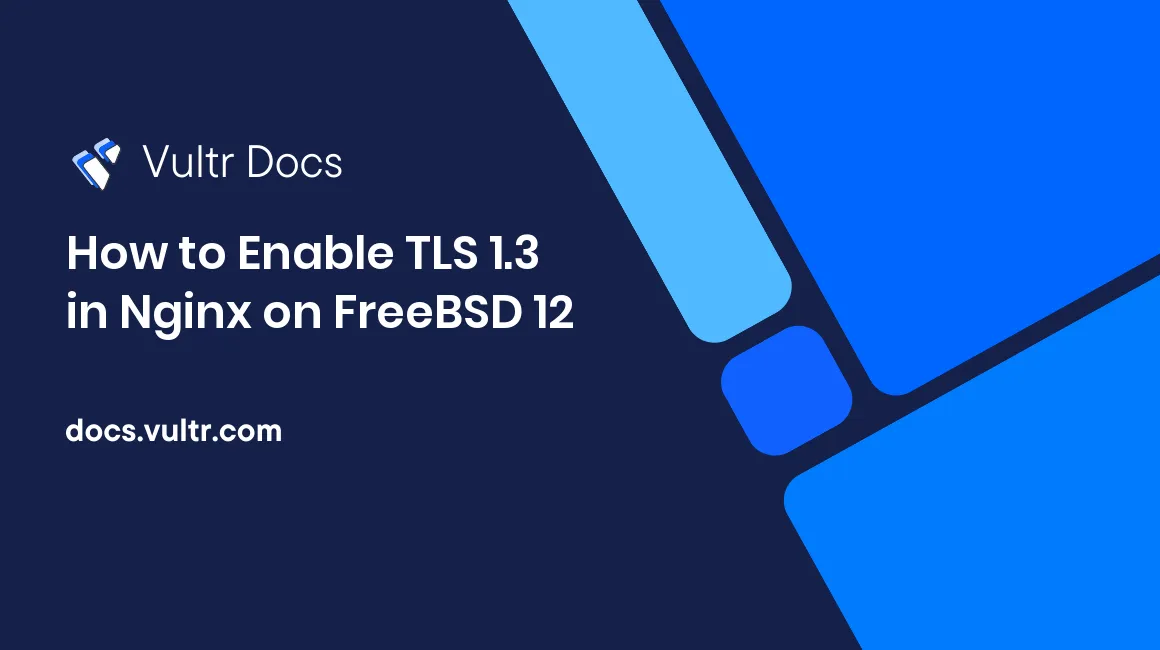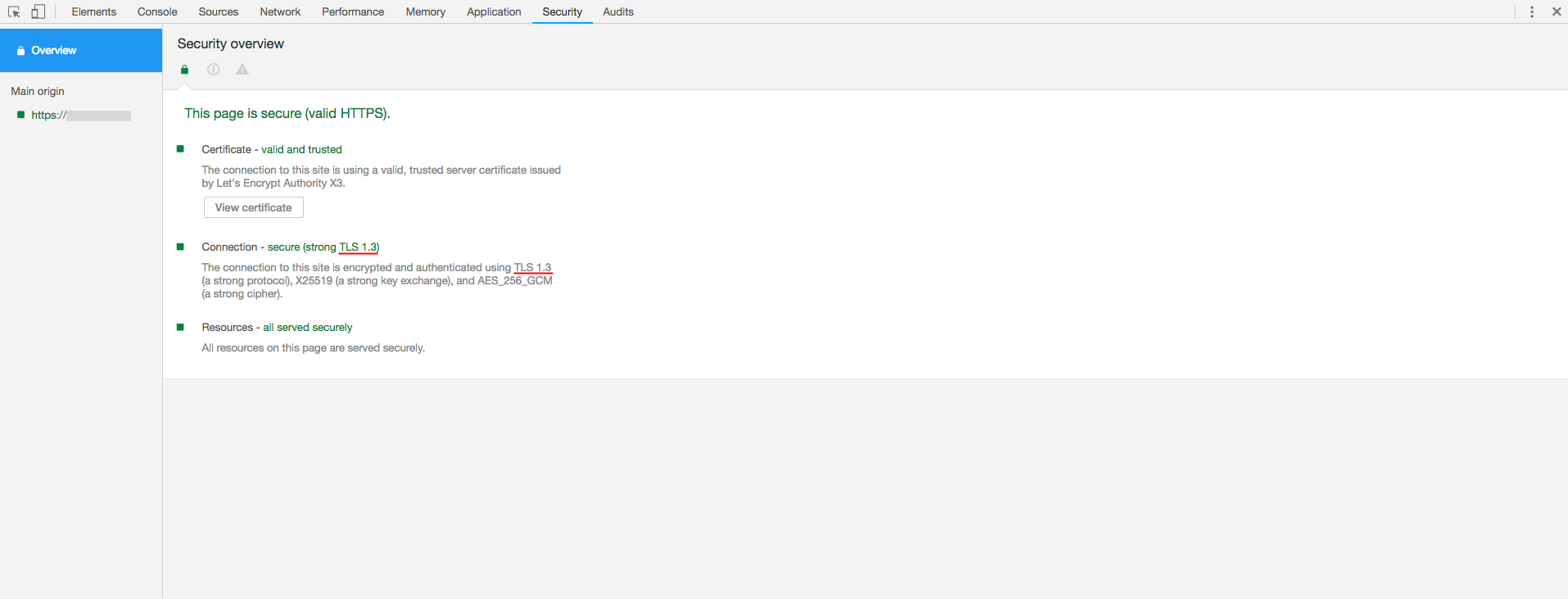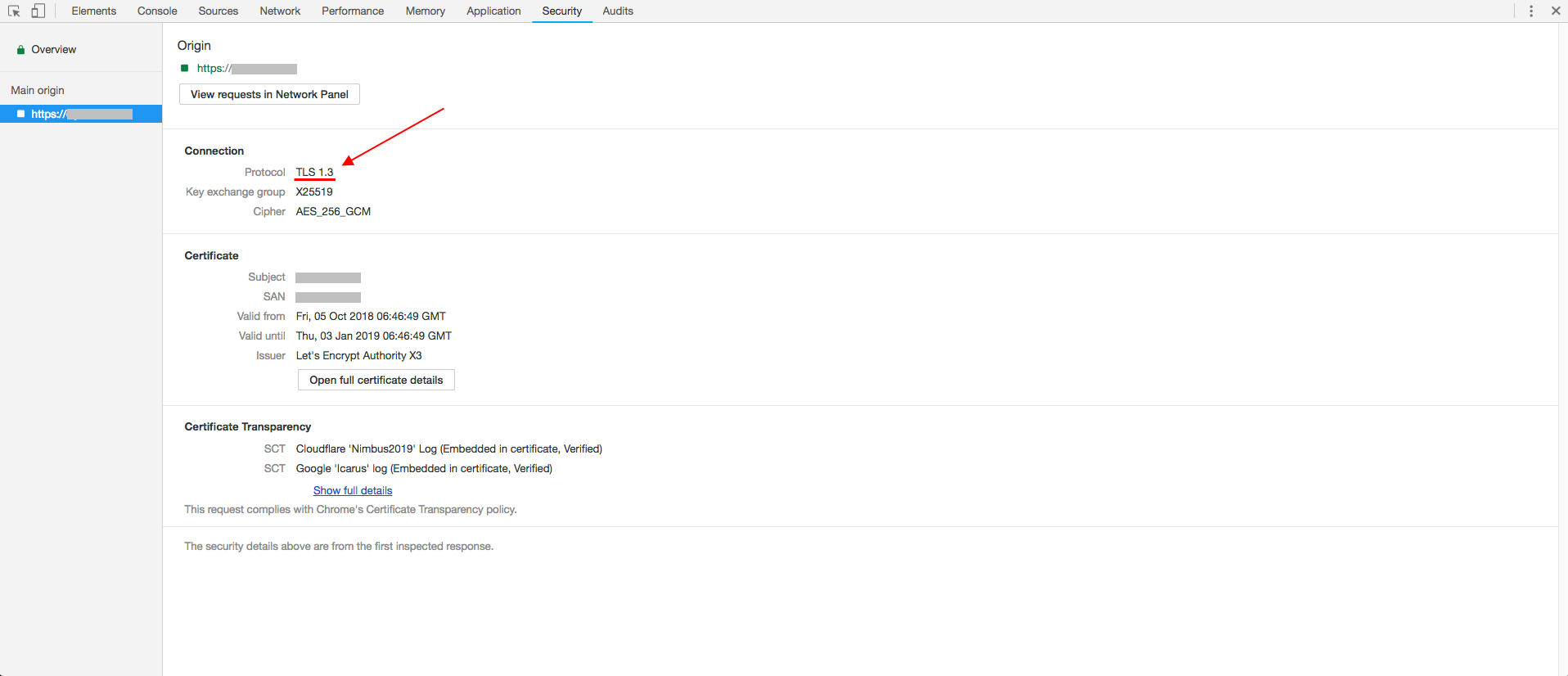
TLS 1.3 is a version of the Transport Layer Security (TLS) protocol that was published in 2018 as a proposed standard in RFC 8446. It offers security and performance improvements over its predecessors.
This guide will demonstrate how to enable TLS 1.3 using the Nginx web server on FreeBSD 12.
Requirements
- Vultr Cloud Compute (VC2) instance running FreeBSD 12.
- A valid domain name and properly configured
A/AAAA/CNAMEDNS records for your domain. - A valid TLS certificate. We will get one from Let's Encrypt.
- Nginx version
1.13.0or greater. - OpenSSL version
1.1.1or greater.
Before you begin
Check the FreeBSD version.
uname -ro
# FreeBSD 12.0-RELEASEEnsure that your FreeBSD system is up to date.
freebsd-update fetch install
pkg update && pkg upgrade -yInstall necessary packages if they are not present on your system.
pkg install -y sudo vim unzip wget bash socat gitCreate a new user account with your preferred username (we will use johndoe).
adduser
# Username: johndoe
# Full name: John Doe
# Uid (Leave empty for default): <Enter>
# Login group [johndoe]: <Enter>
# Login group is johndoe. Invite johndoe into other groups? []: wheel
# Login class [default]: <Enter>
# Shell (sh csh tcsh nologin) [sh]: bash
# Home directory [/home/johndoe]: <Enter>
# Home directory permissions (Leave empty for default): <Enter>
# Use password-based authentication? [yes]: <Enter>
# Use an empty password? (yes/no) [no]: <Enter>
# Use a random password? (yes/no) [no]: <Enter>
# Enter password: your_secure_password
# Enter password again: your_secure_password
# Lock out the account after creation? [no]: <Enter>
# OK? (yes/no): yes
# Add another user? (yes/no): no
# Goodbye!Run the visudo command and uncomment the %wheel ALL=(ALL) ALL line, to allow members of the wheel group to execute any command.
visudo
# Uncomment by removing hash (#) sign
# %wheel ALL=(ALL) ALLNow, switch to your newly created user with su.
su - johndoeNOTE: Replace johndoe with your username.
Set up the timezone.
sudo tzsetupInstall the acme.sh client and obtain TLS certificate from Let's Encrypt
Install acme.sh.
sudo pkg install -y acme.shCheck the version.
acme.sh --version
# v2.7.9Obtain RSA and ECDSA certificates for your domain.
# RSA
sudo acme.sh --issue --standalone -d example.com --ocsp-must-staple --keylength 2048
# ECC/ECDSA
sudo acme.sh --issue --standalone -d example.com --ocsp-must-staple --keylength ec-256NOTE: Replace example.com in the commands with your domain name.
Create directories to store your certs and keys. We will use /etc/letsencrypt.
sudo mkdir -p /etc/letsencrypt/example.com
sudo mkdir -p /etc/letsencrypt/example.com_eccInstall and copy certificates to /etc/letsencrypt directory.
# RSA
sudo acme.sh --install-cert -d example.com --cert-file /etc/letsencrypt/example.com/cert.pem --key-file /etc/letsencrypt/example.com/private.key --fullchain-file /etc/letsencrypt/example.com/fullchain.pem
# ECC/ECDSA
sudo acme.sh --install-cert -d example.com --ecc --cert-file /etc/letsencrypt/example.com_ecc/cert.pem --key-file /etc/letsencrypt/example.com_ecc/private.key --fullchain-file /etc/letsencrypt/example.com_ecc/fullchain.pemAfter running the above commands, your certificates and keys will be in the following locations:
RSA:/etc/letsencrypt/example.comECC/ECDSA:/etc/letsencrypt/example.com_ecc
Install Nginx
Nginx added support for TLS 1.3 in version 1.13.0. FreeBSD 12 system comes with Nginx and OpenSSL that support TLS 1.3 out of the box, so there is no need to build a custom version.
Download and install the latest mainline version of Nginx via the pkg package manager.
sudo pkg install -y nginx-develCheck the version.
nginx -v
# nginx version: nginx/1.15.8Check the OpenSSL version against which Nginx was compiled.
nginx -V
# built with OpenSSL 1.1.1a-freebsd 20 Nov 2018Start and enable Nginx.
sudo sysrc nginx_enable=yes
sudo service nginx startConfigure Nginx
Now that we have successfully installed Nginx, we are ready to configure it with the proper configuration to start using TLS 1.3 on our server.
Run the sudo vim /usr/local/etc/nginx/example.com.conf command, and populate the file with the following configuration.
server {
listen 443 ssl http2;
listen [::]:443 ssl http2;
server_name example.com;
# RSA
ssl_certificate /etc/letsencrypt/example.com/fullchain.pem;
ssl_certificate_key /etc/letsencrypt/example.com/private.key;
# ECDSA
ssl_certificate /etc/letsencrypt/example.com_ecc/fullchain.pem;
ssl_certificate_key /etc/letsencrypt/example.com_ecc/private.key;
ssl_protocols TLSv1.2 TLSv1.3;
ssl_ciphers 'ECDHE-ECDSA-AES256-GCM-SHA384:ECDHE-RSA-AES256-GCM-SHA384:ECDHE-ECDSA-CHACHA20-POLY1305:ECDHE-RSA-CHACHA20-POLY1305:ECDHE-ECDSA-AES128-GCM-SHA256:ECDHE-RSA-AES128-GCM-SHA256:ECDHE-ECDSA-AES256-SHA384:ECDHE-RSA-AES256-SHA384:ECDHE-ECDSA-AES128-SHA256:ECDHE-RSA-AES128-SHA256';
ssl_prefer_server_ciphers on;
}Save the file and exit with Colon+W+Q.
Now we need to include example.com.conf in the main nginx.conf file.
Run sudo vim /usr/local/etc/nginx/nginx.conf and add the following line to the http {} block.
include example.com.conf;Notice the new TLSv1.3 parameter of the ssl_protocols directive. This parameter is only necessary to enable TLS 1.3 on the Nginx server.
Check the configuration.
sudo nginx -tReload Nginx.
sudo service nginx reloadTo verify TLS 1.3, you can use browser dev tools or SSL Labs service. The screenshots below show Chrome's security tab.


You have successfully enabled TLS 1.3 in Nginx on your FreeBSD server. The final version of TLS 1.3 was defined in August 2018, so there’s no better time to start adopting this new technology.
No comments yet.